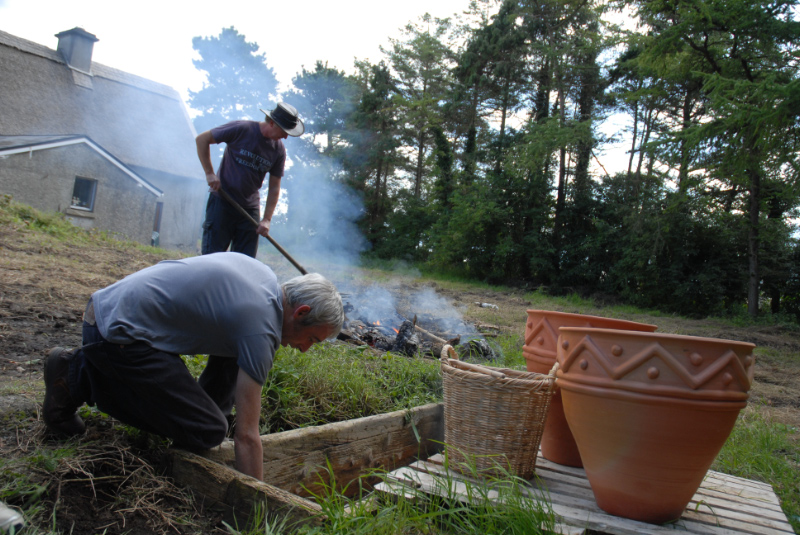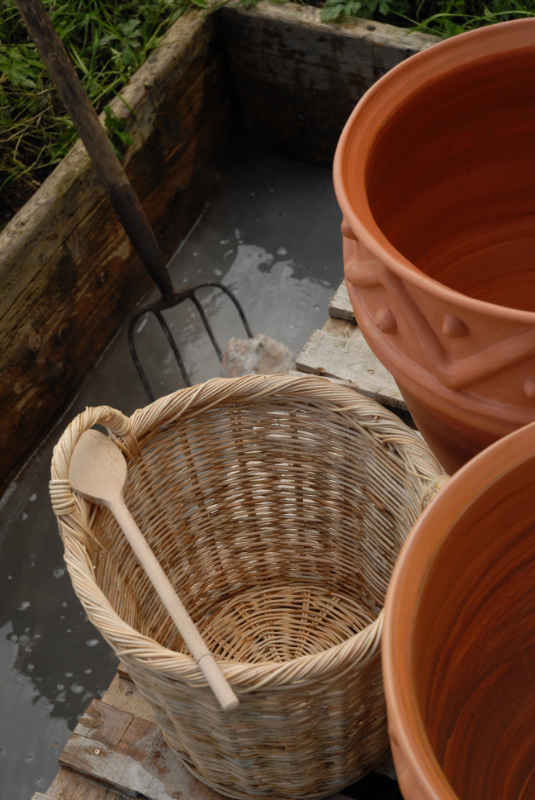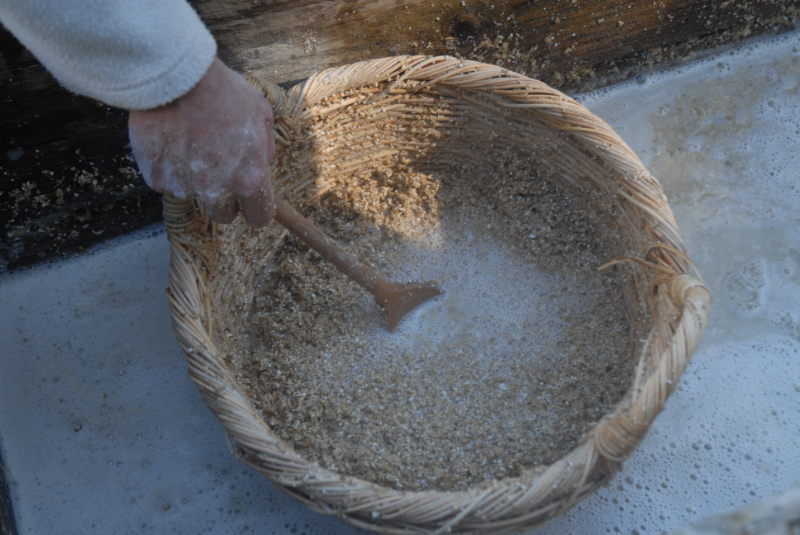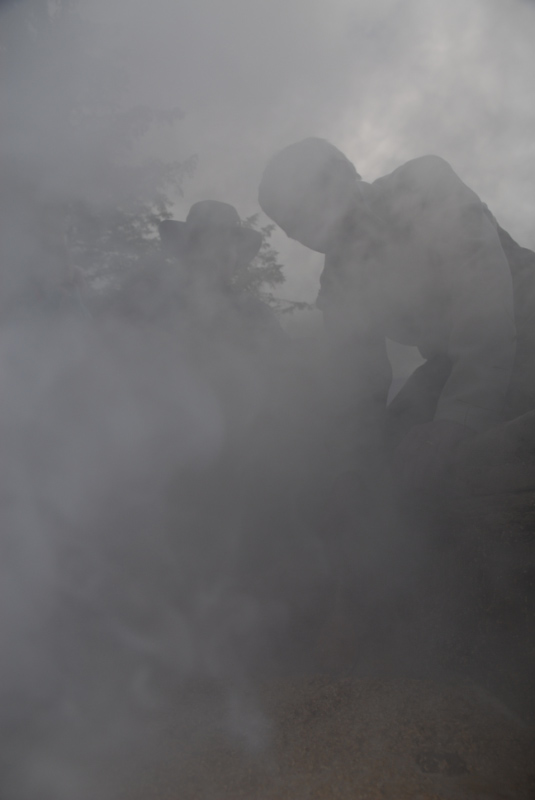Ale, brewing and fulacht fiadh: Archaeology Ireland
Ale, brewing and fulacht fiadh
Billy Quinn and Declan Moore of Moore Environmental and Archaeological Consultants in Galway present a bleary eyed experimental reassessment of the nature and function of fulacht fiadh
The majority of Irish field monuments are defined by their names – a standing stone is a standing stone and a ringfort is a ringfort but not so the fulacht fiadh, characterised by its horseshoe-shaped mound and associated trough. The name derives from Geoffrey Keating’s seventeenth century manuscript Foras Feasa ar Eirinn and as a complete term does not appear in any early manuscripts. Conventional wisdom, based largely on M.J. O’Kelly’s 1952 experiments in Ballyvourney, Co. Cork suggests that they were used for cooking. John Waddell points out that ‘the fact that meat can be boiled in them does not prove that this was their main purpose’. Alternative theories that have been proposed include bathing, dyeing and tanning. It is however, generally agreed that their primary function was to heat water by depositing fired stones into a water-filled trough.
One hungover morning at breakfast, discussing the natural predisposition of all men to seek means to alter our minds, coupled with our innate inquisitiveness (and more mundane preparations for the excavation of a fulacht fiadh), Billy came to a sudden and startling conclusion: fulachts were Ireland’s earliest breweries!
Immediately we set out on a journey of discovery. This quest took us to Barcelona to the Congres Cerveza Prehistorica, and later one evening in Las Ramblas in the company of, among others, an international beer author, an award winning short story writer, a world renowned beer academic and a Canadian Classical scholar – all of whom shared our passion for the early history of beer. In pursuit of the early Northern European brewing evidence we travelled to the Orkneys to meet Merryn and Graham Dineley, an archaeologist and home brewer who taught about ancient brewing techniques. Hot rock brewing technology brought us to Rauchenfels brewery in Marktoberdorf, Germany and finally to Canada.
The History
Studies indicate that hunter-gatherers worked between 4 and 6 hours a day – so what did they do with the rest of the time? Clearly there was a lot of time available for experimentation. Anthropological evidence demonstrates that intoxicants have been part of human society from earliest times. Almost every culture has rites and rituals involving mind-altering substances. Early hunter-gatherers had an intimate knowledge of the environment around them and the effects of naturally occurring intoxicants. As Pete Brown says in Man Walks into a Pub,
even elephants eat fermenting berries deliberately to get pissed and we are much more cleverer than them.
In the 1950s, Braidwood and Sauer, at a symposium for the Journal American Anthropologiest debated whether man once lived by beer alone – essentially asking what prompted the shift from hunter-gatherer to farmer: Was it beer or bread? As Peter Rowley-Conwy states: ‘we call hard but boring work “the daily grind”, a reference to milling cultivated grain, and current research is showing that you didn’t take up farming unless you had to’. The question of how this shift occurred, although intriguing, is academic – somewhere in experimenting with bread or grain, or by happy accident, someone discovered fermentation.

- Preparing for the brew
Recent chemical analyses of residues in pottery jars from the Neolithic village of Jiahu in Northern China by Patrick McGovern revealed that a mixed fermented beverage of rice, honey and fruit was being produced as early as 9,000 years ago. Evidence for the production of beer in the Middle East has long been known – Calcium Oxalate, the principal component of an insoluble deposit known as beerstone was found on the inner surfaces of fermentation vessels at Godin Tepe (late fourth Millennium BC) in the Zagros Mountains in modern day Iran. A stamp seal from Tepe Gawra, a site near Mosul, Iraq dated to 4000 BC, shows two figures drinking beer using traditional straws and container. At Hierakonpolis near Luxor, Jeremy Geller interpreted a site known as HK24A (3100-2890 BC), as a brewery. The world’s earliest written recipe, a Sumerian cuneiform tablet dating to 1800 BC, describes the brewing of beer. The tablet, the Hymn to Ninkasi, known as ‘the Lady of the inebriating fruit’, describes preparing the beer mash in a pit in the ground using ‘sweet aromatics and honey’.
The evidence from Northern Europe is less clear. Large-scale grain processing in the Neolithic in Britain is hinted at by thousands of charred cereal grains found at Balbridie in Scotland, sherds of Grimston-Lyles pottery from pits at Machrie Moor, Arran, were found to contain cereal pollens – interpreted as the remains of a mead-type drink. Based on the high-status drinking vessels characteristic of the Beaker culture it has been suggested that these people traded in some sort of alcoholic beverage. At Ashgrove, in Scotland, archaeologists found evidence of a mixed meadowsweet/lime, a possible mead drink. Compelling evidence for alcohol consumption in early Scotland comes from Perthshire, where Gordon Barclay discovered a ‘black greasy material’ in a food vessel. This residue was radiocarbon dated to 1540 BC and pollen analysis indicated that it represented a cereal-based meadowsweet-flavoured drink. Bohncke, who carried out the palaeobotanical analysis, noted that the high proportion of cereal pollen grains suggested an ale – ‘it is distinctly possible therefore that the North Mains food vessel contained a fermented drink’.
So, if brewing and beer drinking was prevalent and widespread throughout The Levant and The Far East with growing evidence of the same from Late Neolithic and Bronze Age Europe and Britain, and given our prodigious reputation for alcohol consumption (even in Roman Times), where and how did the Bronze Age people brew?
The Ingredients and Equipment
The most basic ingredients for ale are milled, malted grain water, yeast and herbal additives. In terms of facilities and equipment the brewer needs a preparation area for malting, a heat source, grinding equipment, a mash tun (a sufficiently large vessel or pit) containers and a stirrer. The fundamentals of brewing are relatively simple – starches are converted to sugar by heating a mash of milled malted grain to a temperature of approximately 67° Celsius, producing a glucose-rich syrup solution known as a wort. To maximise the sugar yield from the grain the wort is sparged (washed through with hot water). The end product is then transferred to a storage vessel, yeast is added to promote fermentation, flavourings introduced, and several days later the end product is an unhopped ale.

- The tools
Throughout prehistoric Europe one of the main challenges for the brewer (in the absence of suitable metal containers) was heating large volumes of water to make a wort. Indeed, given that brewing until the modern era was a home-based industry, sufficiently large metal mash tuns were uneconomical. So how could people brew without the application of direct heat? Hot rocks are the most logical means. When dropped into a wooden mash tun filled with water and mashed barley, the hot rocks cause the wort to heat -This resulting brew became known in Germany as ‘stein beer’ (stone beer). Until recently the hot rock method was used by Rauchenfels brewery, Bavaria. Here the brewers used greywacke. Sahti, an unhopped ale still served at rural feasts in Finland, is prepared by immersing hot stones into a wooden mash tun to raise the temperature and create a simple ale that is flavoured by filtering it through juniper branches. The tradition has been traced back over 500 years.
The experiment was carried at Billy’s home in Cordarragh, Headford, Co. Galway. Seeking authenticity in replicating our Bronze Age ale we decided that our equipment should be as basic as possible. The wooden trough, posthumously donated by Billy’s granduncle, was 60 years old, leaky, wedge-shaped and measured 1.7 m in length, 0.7 m in width with a depth of 0.65 m (roughly consistent with the average trough dimensions from excavated examples). When filled with water to a depth of 0.55 m, it held 350 litres. In an attempt at caulking the more obvious gaps moss and alluvial clay was applied. Where this process was carried out with care no leaks occurred. After digging a pit, the trough was lowered into the ground and water added. Despite some initial leakage we eventually reached an equilibrium in the water level by simply flooding the immediate area.
In our experience most of the stones contained in the burnt mounds associated with fulacht fiadh are of sandstone or granite. Limestone appears to have been shunned. As O’Kelly observed, heated limestone on contact with water turns to calcium hydroxide. Even in the limestone shelf that constitutes the Aran Islands, Co. Galway, Claire Cotter, excavating in Dún Aenghus, noted that there were numerous fragments of burnt granite cobbles scattered throughout the site, whereas limestone associated with a trough were unburnt – an indication that these erratics were deliberately sought out. For the purposes of our experiment we sourced granite and sandstone from Connemara.
For our Bronze Age brewer after harvesting the barley crop, s/he would have then begun the malting process by first winnowing the grain from the chaff. The next stage would have involved artificially promoting growth by placing the grain in a textile bag or perforated leather container. This would then have been placed in a stream to allow the grains to swell, resulting in the growth of a sprout or ‘acrospire’. The next stage in the process involved stunting this growth to maximise the nutritional value of the grain. This was done by adding gentle heat by rolling hot stones through the grain. The resultant malt is essentially a starch-rich roasted barley seed (grain which has been malted is far more suitable for grinding than unmalted grain). Our malted barley (50 kg) was provided by Aidan Murphy, master brewer with the Galway Hooker Brewing Company. The barley was unmilled and after attempting to grind it using bottles on a hard surface (effective but very slow) we opted for a very Bronze Age electrical food processor.
The first ales were probably fermented by natural airborne yeasts – in Belgium this tradition is continued in the production of Lambic beers. In Norse legend Odin, disguised as an eagle, spilled the secret of beer from the sky. Early brewers learnt that by reusing the stick they had stirred their previous brew with would help to start the next fermentation. One can imagine that these ‘magic sticks’ or ‘wands’ covered with a sticky residue impregnated with living yeast cells would have been invested with a significant spiritual potency. Indeed, the transformative powers of these ‘wands’ in the context of a ritual presided over by a shaman may be likened to Christ at Cana changing the water into wine. In our initial experiment we used brewers yeast. In later brews we used wet yeast.
The Experiment
The stones were heated in a fire for roughly two hours. Step one involved transferring the heated stones into the trough using a shovel. After 15 minutes we achieved our optimum temperature of 60-70c. This temperature is easily identified by observing the surface of the water. As the water heats it becomes thinner, the ripples subside and it becomes glassy and mirror still. The ideal temperature is when the clearest reflection can be seen. At this point we half submerged a wicker basket in the trough and began to add our barley in small amounts to prevent the mash from congealing. Over a period of 45 minutes, maintaining a fairly constant temperature with the addition of occasional heated stones (some of which were recovered from the trough and reheated) our water transformed into a sweet, syrupy, workable wort. If we had decided to add milk, the resultant concoction would be similar to modern day Horlicks or could have been served as porridge or been used to make malt loaf.

- Stirring the wort
After converting the starches to sugar, ascertained by tasting the mash, we brought the mixture to a boil to sterilise it and simply baled the final product into fermentation vessels. We used spigoted plastic containers with a total capacity of 75 litres. In later experiments we used two Bronze Age replica urn-style vessels, each with a capacity of 30 litres made by Seamus Laffin of Roundstone Pottery. Including the leftover liquid we could easily have produced up to 300 litres of wort. At this point we added flavourings, the majority of which were growing around us in Billy’s garden. Thus our ale was flavoured with elderflower heads, juniper berries and some yarrow. These additives were ground in a mortar, wrapped in muslin and suspended in the top of our wort. We added 150 ml of brewer’s yeast after cooling the vessels in a bath of cold water for 3 hours.
Our ale, ready for consumption after only three days, was a relatively clear, copper-coloured brew with a distinctively sharp yet sweet taste. The hot rocks impart a slightly smoky caramelized character. A hard touch of sugar was evident with minimal bitterness and grainy flavour throughout. Overall, the taste was crisp, with a moderate to heavy body. In short it was nice!

- Heating the wort
We produced what is more properly termed a gruit ale (gruit is a term used to describe the herbal mix used to flavour ale). Through our experiments, we discovered that the process of brewing ale in a fulacht using hot rock technology is a simple process. To produce the ale took only a few hours, followed by a three-day wait to allow for fermentation. Three hundred litres of water was transformed into a very palatable 110 litres of ale with minimal work. The real labour for the Bronze Age brewer would have been gathering, malting and milling the barley. The spent grain provided the ingredients for a dozen malt loaves and the rest was used as cattle fodder. Other than the shattered stone and the remains of the fire, there was no wastage.
CONCLUSION
So, what is the evidence for brewing? First, the experiment worked. Fermentation caused by windblown yeast even occurred in the leftover mash in the trough within a few hours. Secondly, a number of quernstones have been found in association with fulachts – indicating that grain processing was taking place nearby. Furthermore the fact that hot rock brewing was carried out to an industrial level until the early part of the last century (and indeed is still practised at a vernacular level in Scandinavian Countries today) testifies to the efficiency of the process.
In conclusion beer at its most basic is fermented liquid bread and is a highly nutritious beverage. Our ancestors would have consumed ale on a daily basis as a healthy, uncontaminated, comfort drink. But this does not preclude the fact that in the long Bronze Age evenings and nights, family groups likely sat around a blazing fire telling tales, interacting socially and enjoying the warmth, wellbeing and genial companionship that ale enhances.
We suggest that the fulacht fiadh was possibly multifunctional, the kitchen sink of the Bronze Age with many conceivable uses. For us, however, a primary use seems clear – these sites were Bronze Age micro-breweries.
Further reading at
O’Neill, J (2004). Lapidibus in igne calefactis coquebatur: The Historical burnt mound ‘tradition’. The Journal of Irish Archaeology Volumes XII and XIII, 2003-2004
http://www.deutsches-museum.de/en/exhibitions/werkstoffe-produktion/agriculture/brewing/.
Nelson, M (2005). The Barbarian’s Beverage: A History of Beer in Ancient Europe. Routledge, NY.
Dineley, Merryn(2004). Barley, Malt and Ale in the Neolithic. Oxford: Archaeopress.
http://brewingtechniques.com/library/styles/6_4style.html
Or visit our website www.mooregroup.ie to view photo gallery of the experiment. We’ll also be posting an extensive bibliography shortly.
Acknowledgements: This project took us to many different countries where we met some great people and sampled strange and exotic beers culminating in the manufacture of our own brew ….. just great craic! We gratefully acknowledge the assistance and advice of Merryn and Graham Dineley, Max Nelson, The Hooker Brewing Company, Pete Brown, Libby Best and Maree Daffy, Moore Group and everyone else who either fed or watered us over the past few years.
This entry was posted on Monday, October 8th, 2007 at 12:50 pm. It is filed under About Archaeology, About Moore Group, About the Beer, Fulacht fiadh, History, Papers & Reports and tagged with About Archaeology, About the Beer, ale, archaeology Ireland, article, brewing, environmental consultants, experiment, Fulacht fiadh, galway, Ireland.
You can follow any responses to this entry through the RSS 2.0 feed.







[…] But then I saw this post all about how folks figured out that ancient Irish people were brewing beer and how they were doing it, and I’m about ready to start digging holes and throwing around hot rocks. I bet that will be useful nowledge after we run out of oil. […]
Hello!
Very Interesting post! Thank you for such interesting resource!
PS: Sorry for my bad english, I’v just started to learn this language 😉
See you!
Your, Raiul Baztepo
Ode to experminental brewing and making archaeology accessable to the masses via this most ancient of fermentated beverages! You’ll be happy to know that I use your research in my Ale Through the Ages brewing seminar at DISCOVERY WORLD museum in Milwaukee (Brew City, USA) http:/distantmirror.wordpress.com
Any recent excavations of fulachts that yielded botanicals or calcium oxilate?
Brilliant! I’ve only stumbled across this blog because I did a search for your company after reading an article about the beer you are making (I’m a Viking Age archaeologist who loves beer – especially non-hopped beer! – so that sort of thing gets my attention! I find your interpretation of fulacht fiadh far more convincing than other interpretations I’ve read (i.e. for cooking shellfish). Inspiring experimental archaeology – and what I wouldn’t give to have enjoyed a taste of that myself 🙂
Ontario, Canada
A cairde,
Tá sé sin do-chreidte siumiúil!
Ar fheabhas ar fad…… Agus mé ag freastal ar cursaí staire agus mé níos óige, dúrú go raibh fia mhór chur i fulacht fiach chun é a cócaráil. Cheapas ansin , go raibh an-chuid dramhail ag baint leis an cleachtadh siúd. Ach mar achmainn chun leann den scoth a dhéanamh, níl aon dabht i mo thuairmse, go raibh baint leis an fulacht fia le sin.
Aon seans go raibh ról ag bláthanna na troime (Sambucus nigra) mar gíosta, seachas giosta fiána i do leann?
Le gach dea ghuí,
alan
Hi Alan
Thanks for your comment. With regards to elderberry or elderflower being used to act as a yeast – that’s certainly a possibility and we did put a little in one of our earlier ales. In general we just use whatever happens to be available at the time of year we choose to brew but it’s likely that ancient brewers retained a year round yeast (perhaps on a stick), and from our experience elderberry is very rich in suitable yeast…
Declan
Nice entry, and I would like to make a few comments but these will have to wait till the weekend! Now is the midst of planting season here in Burundi – working with local folk in agr, lots of work…
[…] Vía| Blog personal de Declan Moore […]
[…] a less hazy telling of this tale, I recommend you go to the source – Dean Moore’s own blog effectively covers the talk he delivered at the European Beer […]
[…] One idea, and the one I like the most, is that they were used for brewing beer. This theory was put forth by Billy Quinn and Declan Moore of Moore Environmental and Archaeological Consultants in Galway. As it is put on their website “One hungover morning at breakfast, discussing the natural predispostion of all men to seek means to alter our minds, coupled with our innate inquisitiveness (and more mundane preparations for the excavation of a fulacht fiadh), Billy came to a sudden and startling conclusion: fulachts were Ireland’s earliest breweries!” You can read the full story on their website at http://www.mooregroup.ie/2007/10/the-archaeology-ireland-article/. […]
[…] eins Fulacht vonseiten Archäologen inside County Galway Bierbrauen über besuchen Declan Moore darüber hinaus Billy Quinn . Pass away einfachen Prozess funktionierte sauber und produziert sehr genießbar (und […]
Has anyone done chemical analysis (chromatography etc) of the wood lining the troughs? Dyes, shellfish and mash leave distinctive different chemical finger prints I would assume, or did all traces disappear through internment under dirt, as unlike the inside of ceramic vessels? Very interesting… p.s. has there been any archaeological evidence for yeast sticks used in ancient brewing? have any of them ever been dug up?
Hi Susan
We’ve had discussions with specialists about lipid analysis but most have contended that natural lipids from the clays would likely contaminate any samples, haven’t heard of any doing chromatography analysis – not sure if the same risk of contamination would apply. As someone else said to me though, we shouldn’t throw the baby out with the bathwater.. we will be carrying out a suite of chemical tests on samples next opportunity we get to excavate a fulacht trough (we’ve been waiting a while for another fulacht excavation). We’ll obviously update here on the blog if and when we next find a fulacht/burnt mound.
Unfortunately I’ve never heard of a yeast stick being found.
Declan
[…] Moore runs The Moore Group archaeological consultancy in Galway city, Ireland. Along with colleague Billy Quinn, he set out to […]
[…] The Fulacht fidha and Brewing […]
[…] There are, all over Ireland, small horseshoe shaped mounds. They are now mostly covered by grass, but beneath the grass are burned, cracked stones clearly damaged by fire, arranged in a central pit, or trough. There are thousands of these fire-marked pits all over Ireland, though they appear particularly common in Cork. You’ll even find these pits marked on the official ordinance survey maps. Carbon dating suggests that most of these pits, known as fulacht fiadh in Ireland, were built between c. 1500 B.C.E. – c. 500 B.C.E. We don’t honestly know what these pits were used for; there have been many suggestions, including cooking meat by boiling it, dye work, and, most recently, an archeologist has suggested they were used for the brewing of ale. […]
[…] Billy Quinn & Declan Moore. Ale, brewing and fulacht fiadh: Archaeology Ireland. http://www.mooregroup.ie/2007/10/the-archaeology-ireland-article/ […]